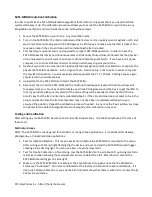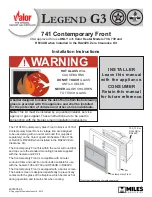
Rotation Tolerance
The Primary Axis Tolerance (deg) sets the allowable deviation of the Yaw (Z) axis from perfect vertical. As long
as the Yaw is within this deviation then the Yaw axis settings will govern the detection of rotation. If the Yaw
axis is past the allowable tolerance then the SATS-MINI will fuse all three X / Y / Z axis to determine rotation
and also use the Tumbling settings for detection.
The Estimation Tolerance (%) is used by some internal code in case of high speed rotation to guard against
sampling aliasing. The SATS-MINI samples at 40 times per second and because of the high sampling rate this
setting may be removed in a future version.
Fixed Wing Specific Flight Mode - Absolute Angle
This detection allows a virtual “flight envelope” to be specified while in Fixed Wing mode. Settings include
maximum pitch forward and back. Also roll both left and right.
Maximum angular rate specified is degrees per second can also be specified for both pitch forward, and
backwards. Also for roll rate for both left or right.
For all detection types a time component can be specified that allows averaging of the measurements. Having
a short time, like 0.1 seconds, means the trigger happens very quickly when exceeding the maximum for a short
time. Having a long time slows the detection down and makes the SATS-MINI more forgiving when moving
quickly in and out of the maximum range.
Like the Miltirotor Yaw trigger Absolute Angle and has this trigger source to guard against fast rotation that
might be a sign of a top-stall, or flat spin.
For all angular trigger setting the value to 0 will disable it.
NOTE:
There is no hard rule which detection type must be used for either flight mode. For example some flyers
may want to use Absolute Angle for both Multirotor and Fixed Wing.
Common Detection Types for all Flight Modes
The remaining detection types are available in both flight modes. Settings in one flight mode are independent
of the other so these can be closely tailored to the specific application.
Free Fall Settings
This setting guards against power failure where the drone falls from the sky. Default settings are acceleration
under 0.3 g detected for 0.5 seconds duration. This should be good for most Multirotor applications. This is
equivalent to about 6 ft of falling. The Free Fall Reset count tells the SATS-MINI how many samples are allowed
where the g force may exceed the threshold to then reset the time. This guards against possible false vibration
from being able to hold off free fall detection. For Fixed Wing use Free Fall may be trickier to use.
Altimeter-Based Fall
This allows the detection of failures where the drone is coming down fast, but not in free fall, or flipping out of
control. This can happen if you have low power where altitude can not be sustained and the drone is not
completely out of control. We call this a “slow motion crash”. (Version 1.1.1 or later).
© Fruity Chutes Inc - https://fruitychutes.com



































